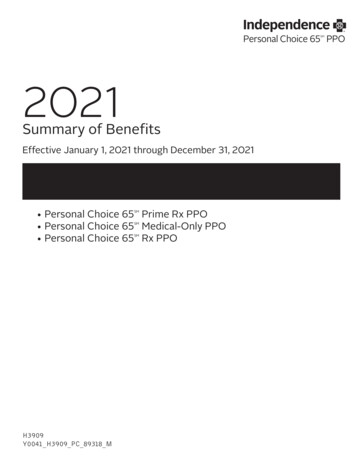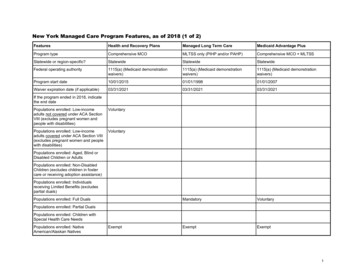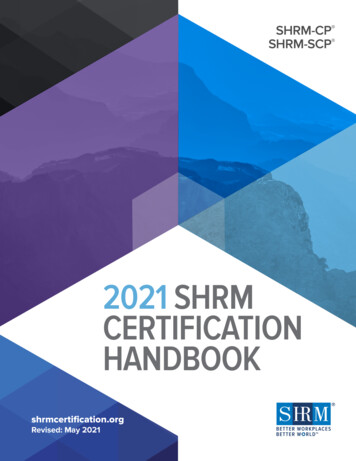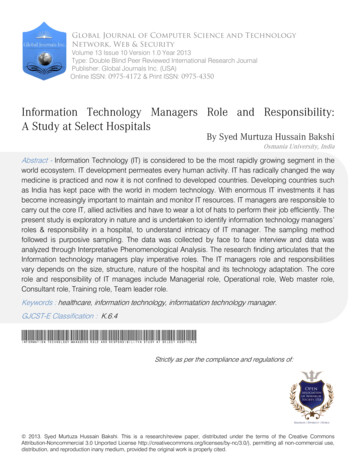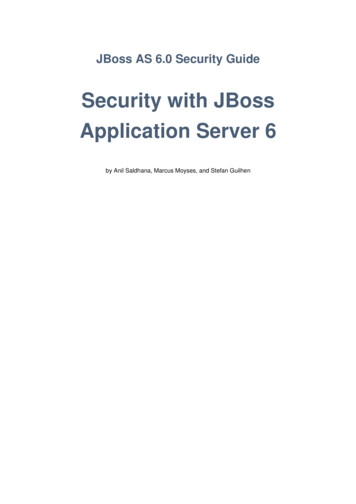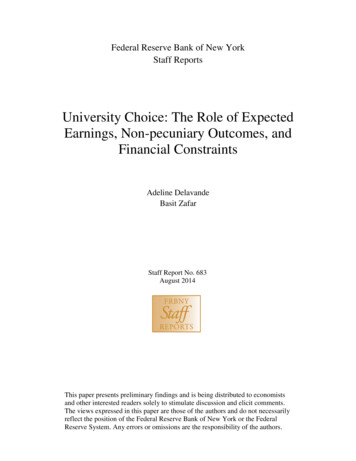
Transcription
Federal Reserve Bank of New YorkStaff ReportsUniversity Choice: The Role of ExpectedEarnings, Non-pecuniary Outcomes, andFinancial ConstraintsAdeline DelavandeBasit ZafarStaff Report No. 683August 2014This paper presents preliminary findings and is being distributed to economistsand other interested readers solely to stimulate discussion and elicit comments.The views expressed in this paper are those of the authors and do not necessarilyreflect the position of the Federal Reserve Bank of New York or the FederalReserve System. Any errors or omissions are the responsibility of the authors.
University Choice: The Role of Expected Earnings, Non-pecuniaryOutcomes, and Financial ConstraintsAdeline Delavande and Basit ZafarFederal Reserve Bank of New York Staff Reports, no. 683August 2014JEL classification: D81, D84, I21, I23AbstractWe investigate the determinants of students’ university choice, with a focus on expectedmonetary returns, non-pecuniary factors enjoyed at school, and financial constraints, in thePakistani context. To mitigate the identification problem concerning the separation ofpreferences, expectations, and markets constraints, we combine rich data on individual-specificsubjective expectations about labor market and non-pecuniary outcomes, with direct measuresof financial constraints and students’ stated school choice both with and without financialconstraints. Estimates from a life-cycle model show that future earnings play a small (butstatistically significant) role. However, non-pecuniary features, such as a school’s ideology, aremajor determinants. Data on students’ choices without financial constraints allow for the out-ofsample validation of the model, which shows a strikingly good fit. Our results demonstrate that37 percent of students are financially constrained in their choice of university, and thatimplementing policies relaxing financial constraints would increase students’ average lifetimesubjective expected utility by 21 percent. From a methodological standpoint, we find thatignoring non-pecuniary factors, uncertainty related to employment and drop-out, or directmeasures of financial constraints yields biased estimates—a result that underscores theimportance of having data on these elements for understanding university choice in any context.Key words: school choice, credit constraints, subjective expectationsDelavande: University of Essex (email: aldela@essex.ac.uk). Zafar: Federal Reserve Bank ofNew York (e-mail: basit.zafar@ny.frb.org). The authors thank Elizabeth Brown, MaricarMabutas and, in particular, Victoria Gregory for outstanding research assistance. For helpfulcomments, they thank Peter Arcidiacono, Sonia Bhalotra, Zach Bleemer, Lance Lochner, ChrisTaber, Todd Stinebrickner, Luis Vasconcelos, and Matthew Wiswall, as well as seminar andconference participants at Duke University, the 2013 AALIMS-Rice University Conference onPolitical Economy of the Muslim World, the Institute for Fiscal Studies, Nova School of Businessand Economics, the University of Essex, the University of Mannheim, the 2013 PoliticalEconomy and Public Services Workshop at the University of Bristol, the 2014 Workshop onSubjective Expectations and Probabilities at the University of Essex, and the 2014 University ofEssex Economics Development Workshop. The authors acknowledge an enormous debt to theirlocal field teams and participating institutions. Funding for data collection through a RANDIndependent Research and Development grant is also gratefully acknowledged. Delavandeacknowledges funding from the Economic and Social Research Council Research Centre onMicro-social Change. The views expressed in this paper are those of the authors and do notnecessarily reflect the position of the Federal Reserve Bank of New York or the Federal ReserveSystem.
1IntroductionHigher education participation has expanded considerably worldwide in the last 50 years, movingin the direction of a mass system of education. The enrolment rate in tertiary education reachesnumbers as high as 96% in Australia, 72% in the US and 71% in South Korea, with entry ratesexceeding 50% for 24 of the 42 countries in the OECD and G20 (OECD, 2013; Lee, 2009). Asa result of this expansion, higher education systems are undergoing changes, such as the growthof for-profit universities in the US, the emergence of a vibrant private sector in many developingcountries, and the creation of universities by religious organizations in Latin America and Asia(Chakrabarti and Grigsby, 2013, Task Force on Higher Education and Society, 2000). High schoolgraduates, therefore, have a very wide range of options of higher education institutions availableto them, which differ in terms of quality, cost and other important characteristics. In this paper, weestimate a life-cycle utility model of university choice to investigate the determinants of the choiceof higher education institutions, and quantify their relative importance.We focus on the role of expected monetary returns, non-pecuniary factors enjoyed at school,and financial constraints in university choice, conditional on participation in higher education. Understanding the relative role of preferences, expectations (or information sets) and market structures is challenging with the type of data on school attendance and family background typicallyavailable (e.g., Cunha and Heckman, 2007). The reason for this challenge is a threefold identification issue. First, expectations about future earnings are usually not observed. Making inferenceon the decision-making process based on choice data and maintained assumptions on earnings’expectations is problematic since observed choices might be consistent with several combinationsof expectations and preferences (e.g., Manski, 1993, 2004). Second, students’ expectations aboutnon-pecuniary outcomes enjoyed while at school are also usually not observed, and as a resultrarely taken into consideration directly. Finally, typically available data do not provide a direct wayof identifying which students are credit constrained (e.g., Lochner and Monge-Naranjo, 2012).In this paper, we use new data on (i) subjective expectations about labor market outcomes,(ii) subjective expectations about non-pecuniary outcomes, (iii) individual-specific choice sets reflecting each student’s budget constraint, and (iii) stated school choice with and without financialconstraints to circumvent those identification issues, and estimate a life-cycle utility model of university choice. We survey male students of college-going age in two urban centers in Pakistan, whoare currently enrolled in different types of colleges and are pursuing a bachelors-equivalent degree.Students are provided with a hypothetical scenario of school choice, and asked to rank five different existing universities in terms of their preference of enrolling in them (assuming guaranteedadmissions), conditional on their current financial status as well as conditional on no school costs.The schools provided in the choice scenario cover the higher education spectrum in Pakistan, rang-1
ing from expensive Western-style elite (private) universities with high labor market returns at oneend to free religious institutions (Madrassas) at the other, with public universities somewhere inthe middle. We use these data to estimate the preference parameter for (log) consumption and fornon-pecuniary factors, and to examine how enrollment would change absent financial constraints.The Pakistani higher education system that we consider is diverse, which is useful to analyzeschool choice. Our setting is also ideal because of the similarity of Pakistan’s education system tothe rest of South Asia. The region accounts for around 25% of the world’s population, with 37% ofthe population under the age of 18 in 2011. Our substantive conclusions are therefore relevant fora quarter of the world population for whom demand for higher education, driven by demographicpressure and rising income, is growing substantially (Economist Intelligence Unit (EIU), 2013).Moreover, because students in other parts of the world face similarly an increasingly diverse rangeof higher education institutions, our methodological contribution is relevant to other developingcountries and, similarly, to developed countries.We find considerable variation in students’ beliefs for the outcomes considered across the different schools, as well as significant heterogeneity in beliefs across individuals within each school.The subjective belief data, however, paint a sensible picture. For example, students believe on average that age 30 earnings conditional on working and graduating from a Western-style universityare substantially higher than those conditional on graduating from a Madrassa. We use the statedschool choice and the elicited subjective expectations to estimate our model of school choice. Theestimates indicate that expected earnings are a significant determinant of the type of universitychosen. However, the elasticity of school choice with regards to earnings is not very high, andvaries between 0.08-0.13. The order of magnitude is similar to that found in educational choicesin developed countries (Arcidiacono, 2004; Beffy et al., 2011; Wiswall and Zafar, forthcoming).With respect to school-specific outcomes, we find that both parents’ approval of the choice and thealignment of school’s teachings with own ideology are very important drivers of the choice, andthat students are willing to give up more than 35% of age 30 consumption to improve the likelihoodof these outcomes by 5 percentage points.We take advantage of the richness of the data to assess the validity of our structural model.We use the preference parameters from our choice model estimated using the stated school choiceunder current financial status and predict student’s school choice if school costs were set to zero.We can then compare those predictions to respondents’ stated school choice under the hypotheticalscenario of no school costs. This is similar in spirit to assessing the validity of a structural modelusing out-of-sample estimation (e.g., Todd and Wolpin, 2006; Galiani et al., 2012). We, however,do not compare the predictions to a different sample, but rather to the same sample in a differentstate of the world (one without school costs). This test relies on the assumption that students areable to correctly predict what they would do absent school costs. The distribution of enrollment2
generated by the model is strikingly similar to the stated choice distribution under no school costs.This strengthens the credibility of the data quality and the modeling assumptions. It also gives usgreater confidence in using the model to simulate alternative policies.We use our estimated parameters to simulate the impact of several sets of policies on students’welfare and enrollment. We find that relaxing financial constraints by providing students with either loans or free schooling (financed by a tax on earnings during students’ later working lives)would increase students’ welfare substantially, with an average (median) gain equal to 21% (8%)in lifetime subjective expected utility. Such reforms would cause more than a third of the studentsto switch schools. Overall, this suggests that financial constraints play a significant role in theintensive margin of university choice in a setting like Pakistan, where well-functioning credit markets are lacking, and borrowing or lending is not possible for schooling. We find limited impactson utility and enrollment of a policy that provides information about objective earnings associatedwith the different school types to students. This is because most students accurately perceive therelative ranking of schools in terms of earnings. We also find that a reform that introduces secular subjects to the Madrassa curriculum – a reform currently underway in Pakistan – would havelimited impact on the choices of students. Finally, making the schools more homogenous in termsof their ideological blend, together with relaxing financial constraints, lead to even larger gainsthan relaxing constraints alone. Note that these policy experiments abstract away from generalequilibrium effects.From a methodological point of view, we show that rich data on expectations and financialconstraints are essential to make credible inference on university choice. For example, in our study,ignoring non-pecuniary outcomes increases the elasticity of school choice to expected earningsby a factor of 1.6. This is because expectations about non-pecuniary factors are correlated withexpectations about monetary returns. Assuming that those non-pecuniary factors are orthogonal tomonetary returns and can be left in the residual (which is what is implicitly done in studies that donot have direct information on those factors) is incorrect -at least in our setting- and would likelyyield biased estimates of choice responsiveness to earnings in many other contexts (see Wiswalland Zafar, forthcoming, for a similar concern in the US). Similarly, ignoring uncertainty relatedto drop-out and unemployment increases the elasticity of school choice to expected earnings bya factor of 1.7. Finally, if instead of using our direct measures of financial constraints we useproxies that are generally used in the literature to measure constraints (such as parents’ income orwealth), we obtain preference parameters for non-monetary factors that are biased upwards, whichas a result yield earnings choice elasticity estimates that are biased downwards by about 25%. Thisunderscores the advantage of collecting direct measures of financial constraints instead of inferringthem indirectly.Our empirical analysis uses respondents’ stated school choice, rather than actual choice, which3
is becoming common in many fields (Louviere et al., 2000). Comparisons of revealed and statedpreference data show that both data sets produce comparable utility parameters (e.g., Adamowiczet al., 1994, Ben-Akiva and Morikawa, 1990, Hensher and Bradley, 1993). Stated choice alsorelates strongly to subsequent actual choice (e.g., Delavande and Manski, 2010). In our context,using stated choice is advantageous because we rely on respondents’ expectations elicited at thetime of the choice in a hypothetical scenario that we seek to explain; this is equivalent to a situation in which respondent’s expectations are elicited before they make their educational decision.This greatly mitigates the issue of the endogeneity of expectations one would face when explainingschool choice made prior to the elicitation of expectations. Yet, we further evaluate the potentialendogeneity concern due to learning and ex-post rationalization by exploiting the variation in students’ duration of enrollment. The underlying assumption is that this concern is likely to be moreserious for students who have been attending an institution for a longer period. Reassuringly, weestimate similar preference parameters for students with different durations of enrollment.This paper relates to various strands of the literature on educational choice. Our paper belongsto a long tradition of work seeking to determine whether expectations about future earnings (orabout returns to schooling) influence college attendance, college major or occupation choice (e.g.,Willis and Rosen, 1979, Berger, 1988, Flyer, 1997, Arcidiacono, 2004, Buchinsky and Leslie,2010, Beffy et al., 2012). The prior literature has relied on various types of assumptions (suchas myopic or rational expectations) for the mapping between realized earnings and expected earnings. However, existing research from both developed and developing countries’ settings has foundthat individuals tend to be misinformed about the returns to schooling (e.g., Betts, 1996, Jensen,2010, Wiswall and Zafar, 2013). This has prompted some empirical work on educational choiceusing expectations data about future earnings (e.g., Giustinelli, 2010, Zafar, 2011a).1 In the last20 years, subjective expectations have increasingly been asked in surveys, yielding meaningfuldata in both developed and developing countries: for example, expectations have been shown tovary with observable characteristics in the same way as actual outcomes (see Manski, 2004, andDelavande, 2014, for a review), and expected outcomes have been found to be strongly associatedwith future outcomes at the individual-level (Dominitz, 1998, Delavande and Rohwedder, 2011).More recently, these data have been shown to be useful to make inference about decision-makingin various domains (e.g., Delavande, 2008, Lochner, 2007, Stinebrickner and Stinebrickner, 2014,Wiswall and Zafar, forthcoming, Zafar, 2013). Importantly, in the educational context, expectations have been shown to be important predictors of schooling choices, above and beyond other1A related line of research, surveyed in Cunha and Heckman (2007), has been to use panel data on earningscombined with college choice information, and a framework in which one can identify (i) components of the life-cycleearnings that are forecastable and acted on at the time of the schooling decision is made, and (ii) components that arenot forecastable. The papers reviewed in Cunha and Heckman (2007) estimate that, for a variety of market structuresand preferences, over 50% of the ex-post variance in returns to college is forecastable.4
standard determinants of schooling (Jacob and Wilder, 2011; Beaman et al., 2012). Admittedly,having expectations data does not free the researchers from any assumptions. For example, identification in our empirical model requires assumptions about expected earnings’ growth.Related to our work, Arcidiacono et al. (2012) and Wiswall and Zafar (forthcoming) use earnings’ expectations to estimate a life-cycle model, focusing on major choice in the US. Attanasioand Kaufmann (forthcoming) examines the role of expectations about returns to schooling and ofperceptions of labor market risks in the decision to continue further education (that is, the extensive margin) in Mexico. We complement these papers by: (1) directly taking into considerationnon-pecuniary outcomes (such as ideology) and additional sources of uncertainty (e.g., regarding dropping out and employment) which are then embedded into a structural model; (2) lookingspecifically at the role of financial constraints; (3) conducting an out-of-sample validation of ourstructural model, and (4) providing the first evidence for understanding university choice on theintensive margin in a developing country setting.Our paper also relates to a large literature investigating the role of credit constraints in highereducation (see Lochner and Monge-Naranjo, 2012, for a review). As mentioned above, this is achallenging task given that most standard data sources do not provide a direct way of identifying which students are credit constrained. The literature has adopted various approaches to dealwith this difficulty.2 Similar in spirit to Stinebrickner and Stinebrickner (2008), our study designbypasses this identification issue by asking students directly which schools are in their budget constraints. This allows us to identify precisely which students are financially constrained in theirschool choice. Furthermore, our structural model also enables us to provide evidence on the importance of credit constraints by simulating various policies that would relax those constraints.3Our paper also builds upon a line of research on the role of non-pecuniary outcomes on educational choice (e.g., D’Haultfoeuille and Maurel, 2013, Jacob and Lefgren, 2007, Stinebricknerand Stinebrickner, forthcoming). For example, Zafar (2013) – using the approach of directly incorporating such elements in the utility function, as we do here – find that enjoying studying thecoursework and gaining approval of parents is instrumental in the choice of majors in the UScontext. Moreover, educational choice elasticities with respect to earnings are typically low (e.g.,Beffy et al., 2012, Wiswall and Zafar, forthcoming), suggesting similarly that non-pecuniary fac2One approach focuses on looking at the role of income (or wealth) on college attendance (and college quality),after controlling for the student’s ability and other family background (e.g., Belley and Lochner, 2007, Cameronand Heckman, 1998, Carneiro and Heckman, 2002, Lowenheim, 2011). Another approach uses differential returnsto schooling for constrained and unconstrained students (e.g., Lang, 1993, Card, 1999, Cameron and Taber, 2004).A third approach estimates structural life-cycle schooling models and evaluates various policies, including relaxingborrowing constraints (e.g., Keane and Wolpin, 2001, Cameron and Taber, 2004).3The literature has largely focused on developed contries. An exception is Kaufman (2012) who studies the importance of credit constraints in university attendance in Mexico and uses, like the current study, subjective expectationsdata on future earnings. Her results suggest the existence of credit constraints. Other papers in developing countriesinclude Gurgand et al. (2012) for South Africa and Soulis (2011) for Chile.5
tors are important. In a developing country setting, we also find non-pecuniary factors to be veryimportant.This paper is organized as follows. We provide an overview of the South Asian and Pakistanieducation systems in Section 2. Section 3 outlines a model of school choice. Section 4 describesthe study design and data collection methodology. We examine heterogeneity in subjective beliefsabout earnings and other school-specific outcomes, and stated school choice in Section 5. Section 6 reports estimates from a structural life-cycle utility model of school choice and provides amethodological discussion of the usefulness of the subjective data, while section 7 presents ourpolicy experiments. Finally, Section 8 concludes.22.1The Educational System in South AsiaHigher Education in South AsiaThe higher education system is organized similarly across South Asia, with flagship universities atthe top of the hierarchy and lower-tier universities absorbing remaining demand (EIU, 2013). Thesoaring demand for higher education has led to the growth of private universities since the mid-80s(notably in India, Afghanistan, Bangladesh and Pakistan), accompanied with a shift of the costsof tuition away from the state and onto students, and uneven quality of education. Only Nepaland Sri Lanka have yet to start the privatization of their higher education system, but there is ageneral recognition across South Asia for the need of new financing models that require universitiesto at least partially finance their own activities. Pakistan has already engaged in this transition:dependence on public funding is limited and universities are increasingly funded through fees andcommercial ventures. Forty-five percent of Pakistani universities are private, a rate between that ofBangladesh and Afghanistan (both at 62%) and India (33%) (EIU, 2013). The substantive growthof the sector has been to some extent at the expense of quality and a resulting low employabilityof graduates.Another common feature is the possibility to acquire higher education outside the universitysystem described above and in Madrassas (Islamic religious schools). The madrassas in MuslimSouth Asia teach a curriculum known as Dars-i-Nizami, which runs from seven to nine years afterthe completion of the elementary level and covers subjects such as (Arabic) grammar, rhetoric,Islamic history, and mathematics. The materials for these subjects are texts dating to before the14th century. A key feature of Madrassas is that they are generally free.6
2.2Education in PakistanOur empirical analysis focuses on Pakistan. Education is compulsory for children aged 5 to 16years and delivered in a public school system in addition to a growing private education sector anda religious education sector.4Higher education takes place in universities. In 2011, the enrollment rate for students betweenthe ages 17-23 was 5.1% (Higher Education Commission Pakistan, 2012). There are now 138universities in the country, of which 75 are public and 63 private (Higher Education CommissionPakistan, 2012). In addition to the recognized private institutions, a large number of illegal private universities operate throughout the country. Both public and private universities have theirown entrance exams which are based on the SAT. Colleges may also base admission decisions onthe Intermediate/Higher Secondary School Examination and/or a personal interview. As explainedabove, it is also possible to continue higher education within the Madrassa system. Advanced studywithin the Madrassas produces an Alim (Islamic scholar and/or teacher), a degree which is considered as equivalent to a Master’s degree in Arabic and Islam by the University Grants Commission.Estimating Madrassas’ enrollment is challenging because fewer than a third are registered (Rashid,2000). However, Ahmad (2004) estimates that there are about 6,000 secondary and higher Madrassas, educating about 600,000 students. Since Madrassas are free, it is commonly believed that theymay offer a viable alternative for families unable to afford more expensive schools (Singer, 2001).5Our study focuses on three types of higher education institutions that represent distinct partsof the higher education spectrum in Pakistan. At one end, we have Western-style universities thatare similar to American colleges. They provide a liberal arts curriculum, classes are taught inEnglish, and have mixed-gender campuses. These are private institutions that charge expensivefees, and cater to primarily wealthy students. Islamic Universities (IU), which are somewhere inthe middle of the spectrum, provide a liberal arts curriculum combined with Islamic teachings andcourses. These universities have segregated campuses for males and females, and classes are taughtin Arabic or English. These institutions tend to be public and, therefore, are accessible to low andmiddle income groups. Finally, at the other end of the spectrum are Madrassas (M). Madrassasdo not impart any vocational training, and most of their graduates go on to work in the religioussector.While returns to schooling are high in a developing country context like Pakistan (Jaffry et4These three sectors provide education in four stages: primary (with a participation rate of 62%), middle (witha participation rate of 35%), secondary (with a participation rate of 23%), and intermediate/higher secondary (with aparticipation rate of 9%) (Lynd, 2007).5The empirical evidence regarding this is mixed: popular media and anecdotal evidence argues that the poorestfamilies send their children to Madrassas (Rahman, 2004; Tavernise, 2009). Andrabi et al. (2006), however, argueagainst the hypothesis that poverty drives individuals to Madrassas: In their sample, they find little difference betweenpoor and rich households in the choice of religious schooling.7
al., 2007), the returns do differ by the type of school, with lower returns associated with publicschooling (relative to private) and for Islamic education (Berman and Stepanyan, 2004; Asadullah,2009). Data from the late 70s however show that unemployment was typically low after graduatingfrom a Madrassa (Ahmad, 2004).3ModelIn this section, we develop a simple model of school choice. A student lives for T 1 periods.In period t 0, the first period of his life, student i acquires education. At the beginning of theperiod, he chooses a school s where he enrolls: At the end of the period, he leaves school by eithergraduating or dropping out, and enters the labor market where he stays till period t 1; :::; T: Inour set-up, the student’s most important decision is the choice of school. The choice is importantnot only because it affects the stream of future earnings (and thus consumption) but also becauseof the following three individual- and school- specific factors that the student values: a1is , whetherthe school’s teachings are consistent with i’s ideology; a2is , whether parents approve of the school,and; a3is , i’s rank at the time of graduation from the school. In addition, i cares about whetherthe school is located in a different town as the one he currently resides in, which is indicated bylis . For tractability, we assume that the utility function is additively separable, linear in the schooloutcomes and location, and logarithmic in consumption. Thus, the utility of individual i fromattending school s is given by:Uis 3Xjj aisTX lis tln(cit ) s "is ;t 0j 1where j is the utility value of outcome ajis , is the utility value of the school’s location, isthe time preference discount factor, cit is i’s consumption at time t, is the utility value of logconsumption, s is a school-specific constant, and "is is a random term which is individual- andschool-specific and unobservable to the econometrician. We incorporate only non-pecuniary factors enjoyed in school in the utility function; there could be other school-specific non-pecuniaryfactors associated with the workplace (for example, if schools had distinct mappings to occupations, and students had tastes for certain occupations), which would be embedded in the randomterm in the current framework. Consistent with the lack of well-functioning credit markets in Pakistan, there is no borrowing or lending possible so student i will consume his earnings yit at everyperiod from t 1 to T . At time t 0, i needs to finance his schooling out of his parent’s earningsyi0 and he faces expected costs Cis if he enrolls in school s. His per-period budget constraints are8
therefore given by:ci0 Cis yi0cit yit for t 1 to T:(1)Because he cannot borrow to finance the school cost, student i solves his maximization problemby restricting his choice set to schools for which the period zero budget constraint ci0 Cis yi0is not violated; that is, schools
University Choice: The Role of Expected Earnings, Non-pecuniary Outcomes, and Financial Constraints Adeline Delavande and Basit Zafar Federal Reserve Bank of New York Staff Reports, no. 683 August 2014 JEL classification: D81, D84, I21, I23 Abstract We investigate the determinants of students' university choice, with a focus on expected



